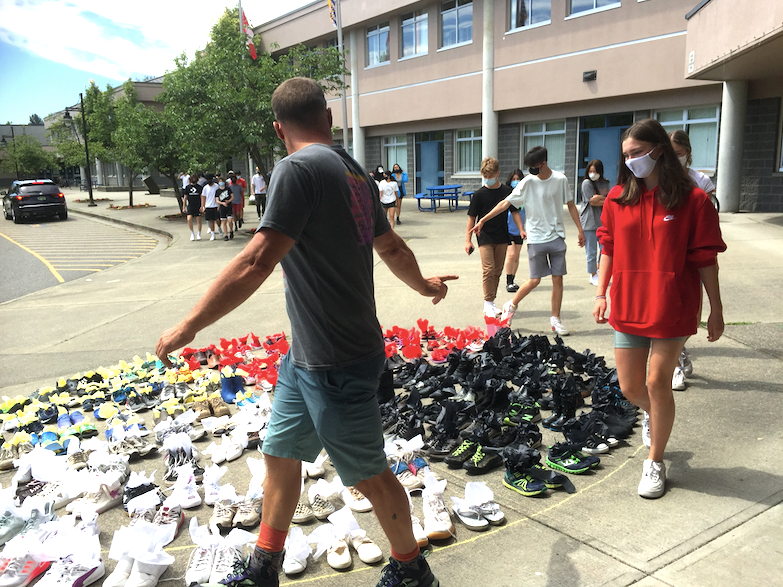The lunch break at Riverside Secondary took a solemn turn this afternoon (June 23) as students filed past a medicine wheel tribute to the 215 children whose remains were found outside a Kamloops residential school.
Some students at the Port Coquitlam school took photos, some made a few comments but the effect of the wheel made up of 215 shoes in colours arranged in a pattern was one of honour, dignity and respect.
And for Mike Gosselin, whose Grade 10 students collected the shoes and arranged the wheel in a traditional Indigenous pattern, the installation gave him a sense of hope for the future.
“Big changes are coming,” Gosselin told the students, “and it’s you [who] are making the changes happen.”
The tribute was arranged in the few weeks since the public was made aware of the discovery of the children’s remains outside the Kamloops Indian Residential School.
Students Kenya Anand, Ahmed Amara, Julia Einarson and Tavish Salmon helped arrange it, and were part of the presentation on Wednesday.
“It gives you a visualization of how many kids were lost,” explained Anand, who is in Grade 10. “You can see the individual pairs of shoes and imagine someone standing in them.”
Indeed, the installation puts a human scale to the tragedy while also imparting the symbolism of the medicine wheel: the four sections represent east, south, west and north and signify the spiritual, emotional, physical and mental aspects of human existence.
Gosselin, who is Métis, said his family has history with the Canadian residential school system: his dad went to Catholic boarding school and his grandmother was a day student at the Labret Indian Industrial Residential School in Saskatchewan.
With his background, he is sensitive to the issue of residential schools and has been teaching his social studies students about the residential school system — long before the discovery at the Kamloops school came to light.
His way of dealing with the story is to think of the children whose remains were found as “dancing” because they have been “found” and now their story can be told.
“What if their spirits are dancing right now because of all the education… suddenly, millions of people are taking notice,” Gosselin said.
“This has never happened before where Canadians stood up and took notice.”
His students, meanwhile, say they have learned some tough lessons by studying the issue of Canadian residential schools.
Amara said he wasn’t surprised to hear of the Kamloops discovery. “I knew there were bodies that haven’t been found,” he said, “There were complaints in the past [by people wanting records and details of burials] but it didn’t work.”
Added Salmon, “I think it’s horrific that it happened here in Canada.”
During the day, classes of Riverside students were invited to visit the memorial, learn about the medicine wheel and stand for two minutes listening to the song Razzle Dazzle by Northern Cree.
“Let’s just picture the children dancing,” Gosselin told the students as they stood in a solemn circle around the colourful collection of shoes.
The shoe collection will now be donated to two Vancouver agencies that serve Indigenous families.



